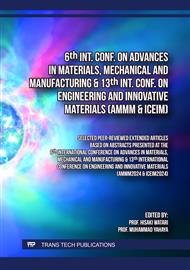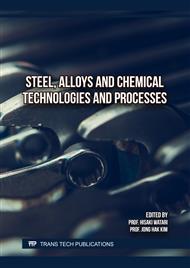p.3
p.17
p.25
p.31
p.37
p.43
p.51
p.57
Effect of Zinc Content and Surface Roughness on the Wettability of Magnesium Alloys
Abstract:
The noise and vibrations generated by equipment and machinery during everyday life and industrial activities can affect both human and machine operations. Specifically, research aimed at suppressing vibrations and noise to enhance the energy efficiency of machinery is becoming increasingly active. In this study, magnesium was selected as the material for vibration damping. The detrimental effects of magnesium are improved by the addition of small amounts of Mn and Zn. A composite material was fabricated using magnesium, which has excellent vibration damping properties, and carbon steel (S45), which has superior mechanical properties. Magnesium alloys with Zn additions of 1, 3, and 5 wt.% were produced to enhance the corrosion resistance and strength of magnesium. Contact angle experiments were conducted to measure the wettability of the magnesium alloys. The contact angle was measured using the sessile drop method. The magnesium alloys showed a decreasing trend in contact angle with increasing zinc content. To explain the decrease in contact angle in Mg-Zn alloys, microstructure and compositional analyses were performed. First, Mg-Fe and Zn-Fe phase diagrams were investigated. The Mg-Fe system was found to contain no intermetallic compounds. In Zn-Fe interactions, Zn appears to form a metallic bond with Fe. The presence of the Γ phase at the interface between the magnesium alloy and S45 indicates that Zn has diffused from the magnesium alloy into both the magnesium alloy and S45. The Γ phase, considered a compound of Fe3Zn10, improves wettability between particles due to the formation of intermetallic compounds. Therefore, it was inferred that the wettability of the magnesium alloy improved. Additionally, improved wettability is expected to contribute to better adhesion processes and potentially increase interfacial shear strength.
Info:
Periodical:
Pages:
31-36
Citation:
Online since:
June 2025
Authors:
Keywords:
Price:
Сopyright:
© 2025 Trans Tech Publications Ltd. All Rights Reserved
Share:
Citation:



